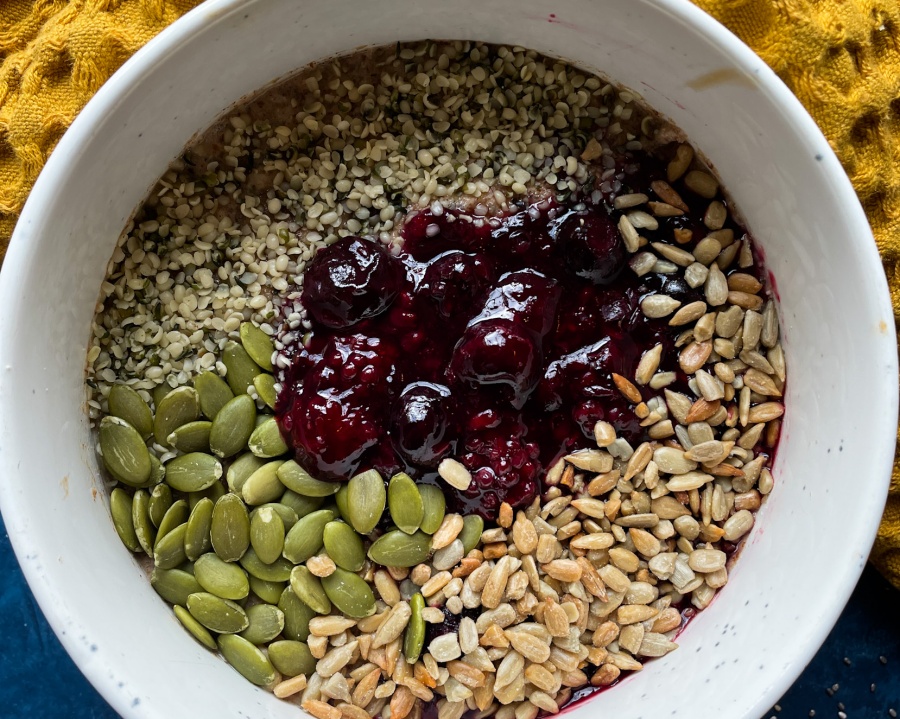How You Can Create A More Balanced Breakfast For Health
When thinking about breakfast foods, what comes to mind?
Perhaps foods labeled “quick” or “on-the-go?” This could look like a pop tart, a waffle, granola bar, or instant oatmeal and cereal. Or maybe it is a banana and a cup of coffee as you run out the door.
Breakfast is the most important meal of the day, but breakfast foods often focus more on convenience and portability, and are chock-full of quick carbohydrates.
In contrast, balanced meals provide the right combination of protein, fat, carbohydrates, and phytonutrients (nutrients from colorful plant sources). When we consume a balanced meal, we’re likely to feel a sense of sustained energy without sugar crashes later in the day.
The Importance of Breakfast
So, what if you don’t quite land your breakfast perfectly? That is what lunch and dinner are for, right?
In the emerging field of chrononutrition, researchers are looking into the relationship between nutrition intake and our body’s natural rhythms.
When it comes to meal timing, a large body of evidence suggests that our largest food intake should be at the beginning of the day. This approach to meal timing allows for better daily energy balance, sleep, and even combats weight gain.
So while you may have lunch and dinner planned just right, you can reap the benefits of optimal meal timing focusing on a balanced breakfast that provides you the energy you need for the rest of your day.
How do we start to shift our outlook on breakfast?
Redefining Breakfast Norms
Believe it or not, breakfast looks very different depending on what part of the world you are in. Traditionally in Costa Rica, breakfast is a rice and bean dish with various spices served with eggs. In countries like China and Columbia, large bowls of soup are the norm with staple ingredients, such as chickpeas and lentils.
Swapping out the Standard American Diet (SAD) breakfast (i.e., a donut) for something less traditional (i.e., soup or savory meal) is a great place to start making changes.
Below are three simple tips for building a better, more balanced breakfast.
Tip #1: Don’t Skip Protein
Protein is essential for building and repairing the body and can help keep us satisfied after a meal. Often, we think of meat, eggs, and poultry as the main sources of protein, but plant sources count, as well. Plant sources of protein include beans, oats, potatoes, spinach, and wild rice.
Tip #2: Focus On Fat
Fat in a meal serves various purposes. It is important for brain and heart health, while also helping provide the body with energy.
Your breakfast meal should focus on omega-3 fats (like nuts and seeds, fatty fish, and grass-fed meat) and limit the amount of inflammatory omega-6 fats that can sneak into processed breakfast foods (i.e., processed vegetable oils from canola and safflower).
Tip #3: Include Carbohydrates But Keep Them Whole Foods
Whole food carbohydrate sources include fruits, vegetables, beans, and lentils, which provide both fiber and phytonutrients. With keeping a balanced breakfast in mind, opt for these whole food options instead of sweets or bread products.
Let’s Try A Balanced Breakfast!
This month’s Better Bites recipe provides healthy fats and protein from nuts and seeds and plenty and phytonutrient-rich carbohydrates from seasonal fruit. Click here for your balanced breakfast porridge recipe!
Better Bites is just one of the monthly wellness offerings available to WellStyles members to help them achieve and maintain optimal health. Reach out to us to learn how being a WellStyles member can help you and your team get on the road to good health.

